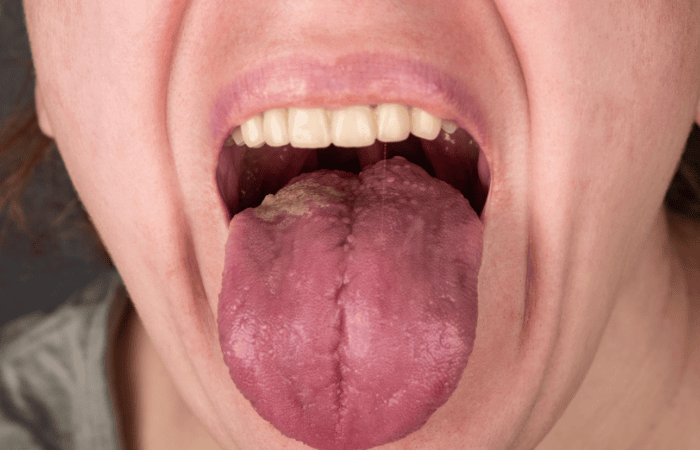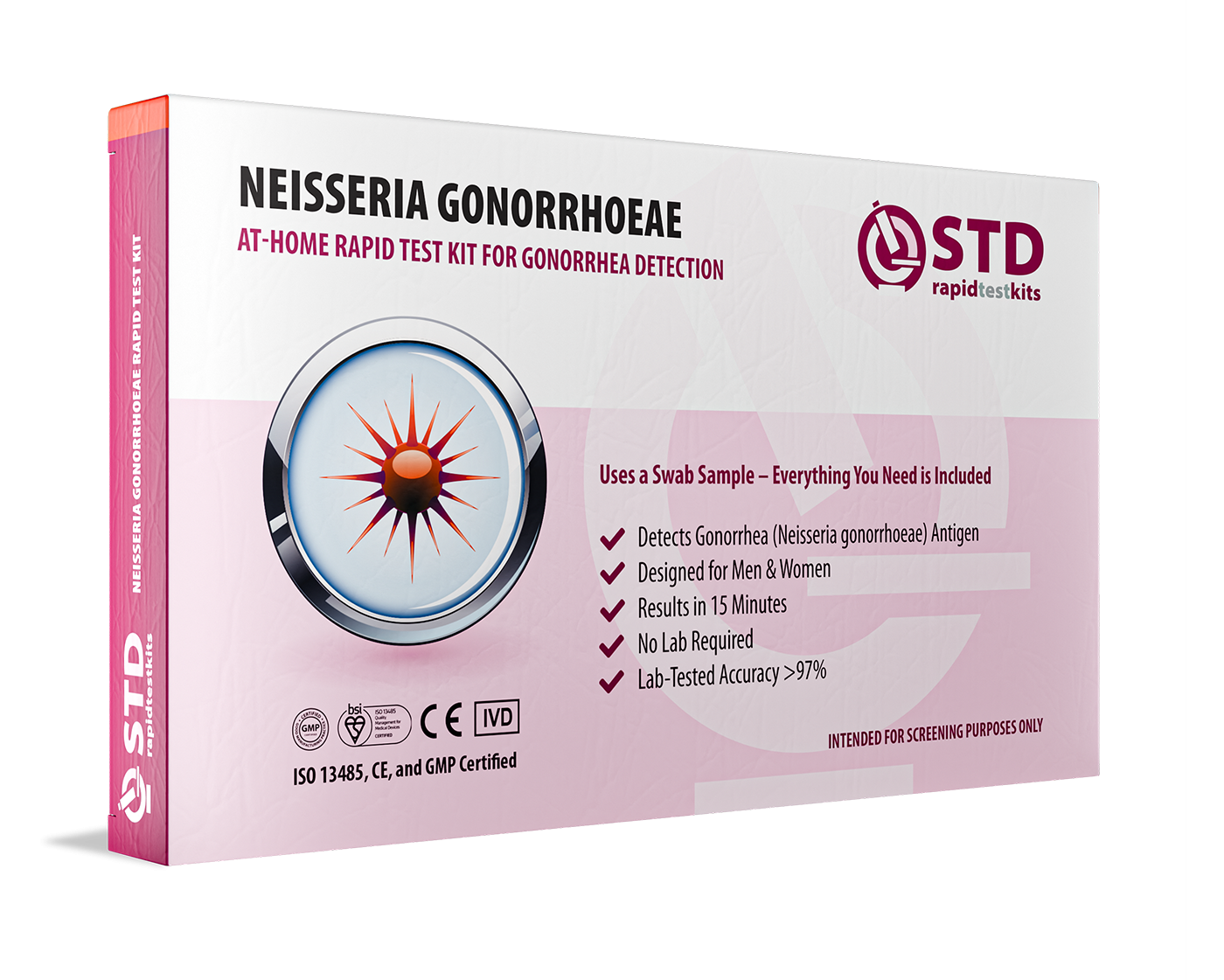Quick Answer: Oral gonorrhea can mimic strep throat, causing redness, white patches, or no symptoms at all. Only a throat swab can confirm it, and you have to ask for it.
Oral Gonorrhea Is Real, and Rising
Gonorrhea is one of the most common bacterial STIs globally, and it's increasingly showing up in the throat. The CDC now warns about pharyngeal gonorrhea (gonorrhea of the throat) as a growing concern, especially in people who give oral sex without protection.
Why is it spreading?
- Oral sex is often unprotected
- Most people don’t realize it can transmit STIs
- Throat infections are frequently asymptomatic
According to studies, up to 15% of men who have sex with men (MSM) and 5–7% of heterosexual women and men may carry oral gonorrhea without knowing it. That means it’s not rare, it’s just rarely tested for.

People are also looking for: This Common STD Could Be Why Your Testicles Hurt
How Oral Gonorrhea Mimics Strep Throat
Here’s the tricky part: oral gonorrhea and strep throat look almost identical. Both can cause:
- Sore, scratchy throat
- Redness or white spots on tonsils
- Swollen lymph nodes
- Fever and fatigue
But unlike strep, gonorrhea doesn’t always respond to standard antibiotics, especially with rising resistance. Many people go through multiple rounds of misdiagnosis before someone thinks to run a gonorrhea swab.
And that delay? It can spread the infection to others, or worsen complications.
Why Most Doctors Don’t Check for It
The majority of urgent care and family doctors don’t swab for STIs when you say “sore throat.” Unless you explicitly report recent oral sex or request an STD test, it won’t cross their radar. Even if you ask for “everything,” most clinics don’t include a throat swab for gonorrhea in routine panels.
This leads to two big problems:
- Silent transmission: You pass it on, never knowing you had it
- Antibiotic resistance: Delayed treatment can make the infection harder to cure
If you've had unprotected oral sex and experience strep-like symptoms, or a sore throat that lingers despite antibiotics, request a gonorrhea throat test. It’s quick, simple, and more accurate than guessing.
Symptoms of Oral Gonorrhea
One of the biggest challenges with oral gonorrhea is how often it shows no symptoms at all. Still, when symptoms do appear, they’re easy to mistake for something else.
Possible signs include:
- Persistent sore throat
- Swollen tonsils with or without white patches
- Redness at the back of the throat
- Swollen or tender lymph nodes in the neck
- Fever, fatigue, or headache
Sometimes, the only clue is a strep test that comes back negative, but the symptoms won’t quit. That’s the moment to ask: Could this be something else?
Order Now $129.00 $343.00 Check Your STD Status in Minutes
Test at Home with Remedium
7-in-1 STD Test Kit




For all 7 tests
How Oral Gonorrhea Is Transmitted
Oral gonorrhea is spread through mouth-to-genital or mouth-to-anus contact. Giving oral sex to someone with genital or anal gonorrhea puts you at risk. You can also acquire oral gonorrhea through kissing if it involves transmission of infected fluids, though this is rare.
Risk factors include:
- Multiple partners
- Lack of barrier use (condoms, dental dams)
- Sexual activity with partners who have untreated STIs
- Anonymous or group sex settings where follow-up is difficult
Using protection during oral sex isn’t just about pregnancy, it’s about protecting your throat from bacteria that can make you sick, infectious, or both.
Testing: What You Need to Ask For
If you’ve had oral sex and experience a sore throat, don’t settle for a strep test alone. Request a throat swab for gonorrhea and chlamydia. Most doctors won’t run this unless you specifically mention oral exposure or STI concerns.
Ask for:
- NAAT (Nucleic Acid Amplification Test) for throat swabs – gold standard for detecting oral STIs
- Extra-genital screening – especially if you also engage in anal sex
- Full STI panel – including HIV, syphilis, and hepatitis, if relevant
STD Rapid Test Kits offers at-home options that include throat swabs for oral STIs, making it easier to test discreetly and accurately, especially if your provider refuses or you can’t access a clinic easily.
Treatment for Oral Gonorrhea
Treating oral gonorrhea is usually straightforward, if it’s caught early. But this site of infection is becoming a hotspot for antibiotic resistance, making timely and accurate treatment critical.
Current CDC guidelines recommend:
- Ceftriaxone injection (500 mg IM) for uncomplicated cases
- Re-testing after 7–14 days if symptoms persist or partner is untreated
Do not attempt to self-treat with leftover antibiotics or online pills. Oral gonorrhea needs specific, high-dose treatment, and using the wrong antibiotic can drive resistance.
It’s also crucial to tell recent partners so they can get tested and treated. Even if they’re asymptomatic, they can keep the infection moving through your community.

People are also looking for: Yes, You Can Give Someone Genital Herpes With a Cold Sore
The Problem of Reinfection
One of the most frustrating realities about oral gonorrhea? It often comes back. If a partner isn’t treated, or if treatment was incomplete, you can easily be reinfected, even within a few days.
Prevention tips:
- Don’t have sex for 7 days after completing treatment
- Make sure all partners are treated before resuming activity
- Use condoms or dental dams during oral sex when possible
- Regularly test every 3–6 months if you’re sexually active with new/multiple partners
This isn’t about shame, it’s about facts. You can get oral gonorrhea more than once, and clearing it once doesn’t mean you’re immune. Staying proactive is key.
Long-Term Risks If Left Untreated
If you don’t catch oral gonorrhea, you risk more than just an annoying sore throat. It can lead to:
- Chronic pharyngitis (ongoing throat pain and irritation)
- Spread to other parts of the body (e.g., urethra, rectum, reproductive system)
- Increased risk of acquiring or transmitting HIV
- Antibiotic-resistant strains becoming harder to treat
This is why routine STI screening should always include oral sites if you’re sexually active in ways that involve the mouth. Don’t let an invisible infection linger in your throat.
“I Had Strep. Or So I Thought."
Kai, 29, thought they were dealing with just another sore throat. The symptoms matched: pain when swallowing, white streaks on their tonsils, fatigue. Urgent care ran a rapid strep test, it came back negative. Still, the doctor sent Kai home with amoxicillin, “just in case.”
“It didn’t get better. The swelling stayed. I went through two rounds of antibiotics before a friend asked if I’d had a throat swab for STDs.”
After insisting on a full panel with extra-genital testing, Kai finally got the answer: oral gonorrhea. With the right injection, the symptoms vanished in days. But the real pain? Knowing it could’ve been solved weeks earlier, if someone had just asked about their sexual history.
Misdiagnosis isn’t rare, it’s routine. Gonorrhea often hides in plain sight. Don’t wait for doctors to connect the dots. Ask for the swab.
Check Your STD Status in Minutes
Test at Home with RemediumGonorrhea Test Kit

 For Men & Women
For Men & Women Results in Minutes
Results in Minutes No Lab Needed
No Lab Needed Private & Discreet
Private & DiscreetOrder Now $33.99 $49.00
Protection During Oral: What Actually Works?
Let’s talk about something rarely covered in mainstream sex ed: how to protect your mouth during oral sex. Most people skip condoms or dental dams when it comes to giving oral, but that’s exactly how infections like gonorrhea get passed around silently.
- External condoms: Best for oral on a penis, use flavored versions if taste is an issue
- Internal condoms: Can be used in the vagina or anus before oral or rimming
- Dental dams: Thin latex sheets placed over the vulva or anus, easy to use with lube
- DIY barrier: Cut open a condom or use non-microwaveable plastic wrap in a pinch
It’s not about killing the mood. It’s about staying empowered. These tools can actually become part of the turn-on when used with intention and creativity. And they make a huge difference in reducing oral STI transmission.
What About Chlamydia in the Throat?
Gonorrhea isn’t the only bacterial STI that shows up in your throat. Chlamydia can also infect the pharynx, especially through unprotected oral sex. Like oral gonorrhea, it’s often asymptomatic and almost never screened for unless you ask.
The difference? Chlamydia is less likely to cause visible symptoms in the throat but can still:
- Cause low-grade throat irritation
- Persist for months without detection
- Be transmitted back to a partner’s genitals
And here’s the kicker: many people have both chlamydia and gonorrhea simultaneously. If you’re testing one, test for both. Most modern NAAT swabs can detect both pathogens with a single throat sample.
This is why extra-genital testing matters. If you’re only testing your urine, you’re missing half the picture.
Why Shame Still Delays Testing, And How to Push Past It
Let’s be real: walking into a clinic and asking for an oral gonorrhea test can feel intimidating. The stigma is still strong. People worry they’ll be judged, for giving head, for having multiple partners, or even just for being proactive.
But shame has consequences. It leads to silence, delays diagnosis, and allows infections to spread. The longer oral gonorrhea goes untreated, the greater the chance of complications and reinfection. It’s not worth the risk just to avoid an awkward moment with a provider.
Your health shouldn’t hinge on comfort. But with modern tools, it doesn’t have to.
People are also looking for: How Chlamydia Can Affect Babies When the Mother is Infected
FAQs
1. Can gonorrhea live in the throat?
Yes. It’s called pharyngeal gonorrhea and can be transmitted through oral sex.
2. How do I know if it’s strep or gonorrhea?
Symptoms can be nearly identical. If strep tests are negative, ask for a gonorrhea throat swab.
3. Is oral gonorrhea dangerous?
If untreated, yes. It can spread, cause chronic symptoms, and contribute to antibiotic resistance.
4. Does kissing spread oral gonorrhea?
It’s very rare. The main risk is from oral-genital or oral-anal sex, not kissing.
5. How long does oral gonorrhea last?
It can persist indefinitely if untreated. With proper treatment, it typically clears within a week.
6. Can you treat it at home?
You can test at home, but treatment requires prescription antibiotics. Don’t try to self-medicate.
7. Should I tell my partners?
Yes. They may need treatment even if they don’t have symptoms.
8. Will regular STD panels catch it?
No. You must request a throat swab. It’s not included by default.
9. Is it common?
Yes, especially among people who engage in oral sex. Most don’t realize they have it.
10. Where can I get tested?
Use STD Rapid Test Kits for at-home throat swab testing, or request it at a clinic.
Ask For The Test
Not every sore throat is strep. In an era of antibiotic resistance and expanding STI rates, we need to rethink what symptoms mean, especially when they don’t go away. Oral gonorrhea is real, it’s rising, and it’s often misdiagnosed. If you’re sexually active and your throat won’t heal, trust your instincts. Ask for the test. Push past stigma. And if your doctor won’t listen, take matters into your own hands with discreet at-home testing options.
Knowing what’s in your body isn’t paranoia, it’s power. Because the only thing worse than catching an STI is not knowing you have it.
Sources
1. How to Identify, Treat, and Prevent Oral Gonorrhea – Healthline
2. Oral Gonorrhea vs. Strep Throat: What Sets Them Apart? – Docus.ai
3. Oral Gonorrhea vs. Strep Throat: Key Differences – LifeMD
4. Oral Gonorrhea vs. Strep Throat: What to Know – Everlywell
5. Gonorrhea in Throat: Understanding the Silent Threat – ToplineMD










